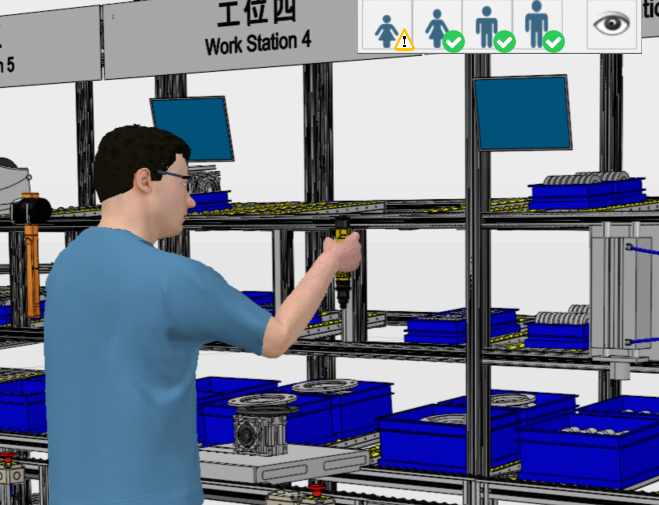
This was originally published as a LinkedIn Article by Julie Charland.
If you haven’t heard of virtual ergonomics, it is normal.
As a manufacturing engineer, one of your focuses is to design safe workplaces in your factory. Ergonomic assessment while in the virtual world (Virtual Ergonomics) can help you do just that:
Find ergonomic issues as soon as possible in the virtual world in order to increase workers well-being and productivity and reduce costs related to musculoskeletal disorders in the real world.
At this point, you may be wondering:
“Why haven’t I heard about Virtual Ergonomics and why am I not using this”?
If this is the case, you might be interested in the following story. It goes like this:
1. The Future of Virtual Ergonomics
In 2015, I was honored to receive an invitation to write a chapter in a German textbook on digital human models (DHM) and virtual ergonomics. The funny thing is that, as a master procrastinator, I should have said “no” to such project but… with a perfect mix of enthusiasm and innocence, I normally end up saying “yes”. So after days, weeks, and months of wandering in this procrastination world, I finally delivered “Virtual Ergonomics – Vision of the Future: from geeks only to anyone involved in product and workplace design“.
You can read the whole chapter here but here’s an extract:
The first thought that came into my mind when thinking about “Vision of the Future” for Digital Human Modeling (DHM) and Virtual Ergonomics is a quote from Alan Kay: “The best way to predict the future is to invent it”. With this in mind, it helps in reaching a mindset where the future looks like an attractive place with a lot of room to create and innovate.
Since the beginning of my career I have had the privilege to meet a large number of stakeholders such as users, software developers, technology and business partners, professors, students and researchers. All of them were connected directly or indirectly to DHM. I do not own a crystal ball but thinking deeply about my years of experience and interactions with those stakeholders, I believe the future of Virtual Ergonomics will take shape through a better understanding of existing and future users of Digital Human Modelings.
DHM existing users and future users, don’t know what they don’t know […] Kim Goodwill would rather say […] the users are the only experts in what their problems are, but that they are seldom equipped with the expertise to solve those problems. “It was not officially proven that this quote was actually said by Henry Ford but I like using this story to better explain what I mean: “If I had asked people what they wanted, they would have said faster horses.” Because he listened to the request while being able to think as if he was wearing the users’ shoes, he did not quite do what the users asked for but created the automotive instead which provided by far a more effective solution to the users’ problem. This inventor did not focus on the suggested solution verbalized but rather the users’ request per se: faster and usable even on rough roads. I believe the same type of listening needs to be done for Digital Human Modeling users and future users. And this is how I got to the finding I previously made: solutions that will help them take decisions so that they can produce desirable products and safe workstations, whatever their ergonomics knowledge level is.
The future of DHM still needs to include the experts: the geeks who are both 3D experts and ergonomists. However, I believe a Digital Human Modeling solution should focus on the non-experts: those working in 3D who do not have any or very little ergonomics background. They represent the key entry to ergonomics.
So, the reason why you might haven’t heard about virtual ergonomics or aren’t using it is because it was reserved for experts.
2. “The best way to predict the future is to invent it.” Alan Kay
During the last decade, the Montreal based Dassault Systèmes (3DS) team dedicated to Virtual industrial Ergonomics software has been busy inventing the future by thinking and articulating this Vision:
To bridge the world of 3D and Ergonomics by providing relevant and useful ergonomics guidance to product and workplace designers with low ergonomic background in order to help them take quick and efficient decisions to reach their design goals.
The 3 key ingredients to democratize virtual ergonomics (ie: putting Virtual ergonomics in your hands) are the following:
- Talk the user talk: Resources, MBOM and operations already defined in the process plan are directly used as inputs for worker task creation.
- More time to improve the workplace +less time to posture the digital manikin: Automatic manikin posture creation for each worker task with the “Smart Posturing Engine” TM technology.
- Ergonomic guidance for non-ergonomists: Industry standards-based ergonomic risk level assessment for each worker task as well as suggestions to lower ergonomic risk driven by “Ergo4all” TM technology. Direct link with a certified ergonomist when needed.
These 3 ingredients are at the heart of DELMIA Ergonomic Workplace Designer. As a manufacturing engineer, you now have the possibility to do your job while developing an ergonomic mindset. How does that sound?
How to get started
Check out the demo “An Example of Ergonomic Workplace Design | DELMIA” on YouTube:
Additional resources:
Continue the conversation by joining the DELMIA Ergonomics Community here. Membership is free.
